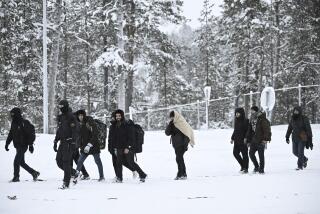Cut Off When Soviets Closed Border in ’38 : Turkish Families: So Close, Yet So Far
- Share via
SARP, Turkey — Burhan Cakir has not seen his relatives for almost 50 years, although they live just a few hundred yards away on the other side of this Black Sea fishing village.
He knows some of them are still there, because they occasionally write to him.
They are separated by a small babbling stream, somewhat grandiosely called the Kabis River, that is barely a yard wide and cascades down from the mountains. The Turkish-Soviet border runs down the middle.
At night, the 509 inhabitants of Sarp, Turkey, can see lights and television sets twinkling in the homes of their kin in Sarpi, Soviet Union.
The border was closed by the Russians in 1938. Now villagers hope they may finally be able to see surviving relatives in 1987, when the border is due to reopen to help promote trade between Ankara and Moscow.
Gray Rail Fence
A chest-high, gray rail fence runs along the Soviet side of the stream.
Above the village, the terrain becomes so rough that the frontier is marked only by milestones, though it is heavily patrolled by Soviet border guards.
For the moment, the only people to cross the red-and-white striped wooden bridge that separates Sarp from Sarpi are Turkish and Soviet officers for occasional talks on border problems.
Meetings are called by raising a flag beside the bridge.
They are held around a green felt-topped table, decked out with the Turkish and Soviet flags, in the protocol room of one of the two border posts.
On the Turkish side, the most striking feature of the room is a painting of the triumphant Ottoman Sultan Mehmet at the conquest of Istanbul (then Constantinople) in 1453. The quotation beneath it says: “I will defend my border even if I have only one arm and one hand left.”
The Turkish authorities are sensitive about the border. Sarp is in a restricted zone and journalists escorted there on a rare visit--by accident or design under cover of darkness--were barred from taking photographs.
At the most recent border meeting, the two sides discussed minor disputes arising from seasonal changes in the course of the Kabis river.
“We have never had a serious incident,” he said.
On the Soviet side, a red-and-green milestone and a large sign saying “Union of Soviet Socialist Republics” in Russian stand in front of a gate in the gray fence. Guard dogs can be heard barking in the distance.
There is no fence on the Turkish side, just a sign with the Turkish national emblem and a mosque.
The people of Sarp, who scratch a poor living from fishing and growing tea, have had virtually no contact with their families in Sarpi since the border closed.
The only exceptions are a few elderly people from Sarpi who are allowed one three-month visit to Turkey every five years. They have to enter the country through the only open border post, about 100 miles southeast of Sarp.
“Only four or five people have come over in all the time I can remember, and they didn’t like to talk much about life on the other side,” said Cakir, the village muhtar (headman) of Sarp.
The Turkish authorities made sure that the visitors from Sarpi returned home at the end of their stay, he said.
Speaking cautiously under the watchful eye of Turkish border guards, Cakir said he had no interest in seeing the Soviet side of the village when the border reopens.
“I don’t think we would want to go there. But perhaps they would want to come here to shop,” he said.
More to Read
Sign up for Essential California
The most important California stories and recommendations in your inbox every morning.
You may occasionally receive promotional content from the Los Angeles Times.













